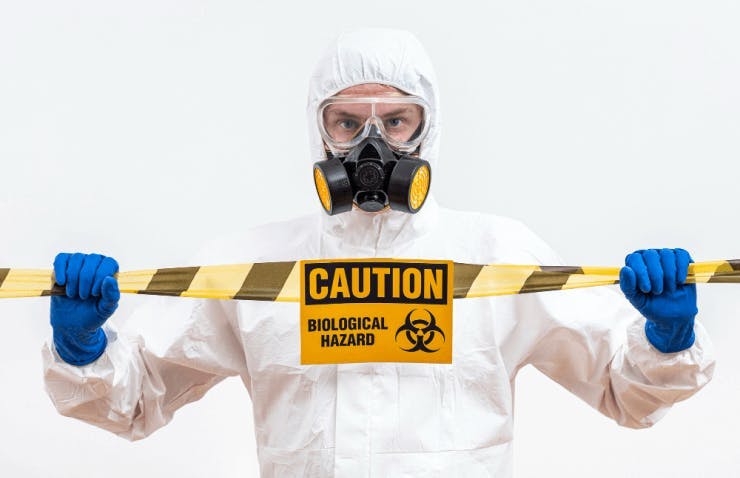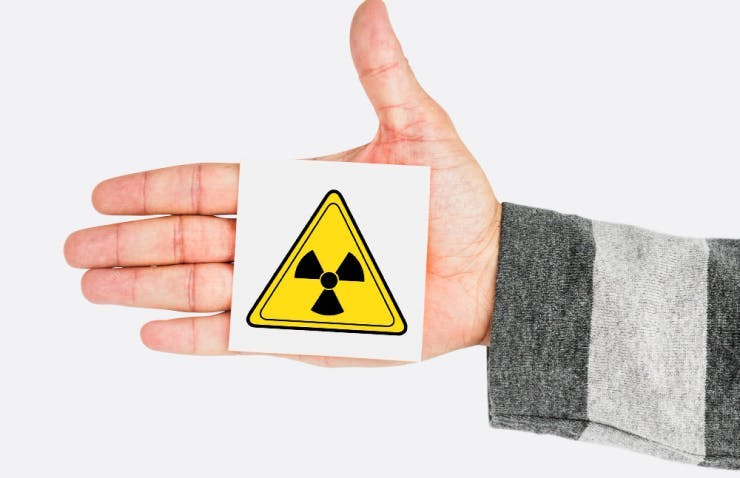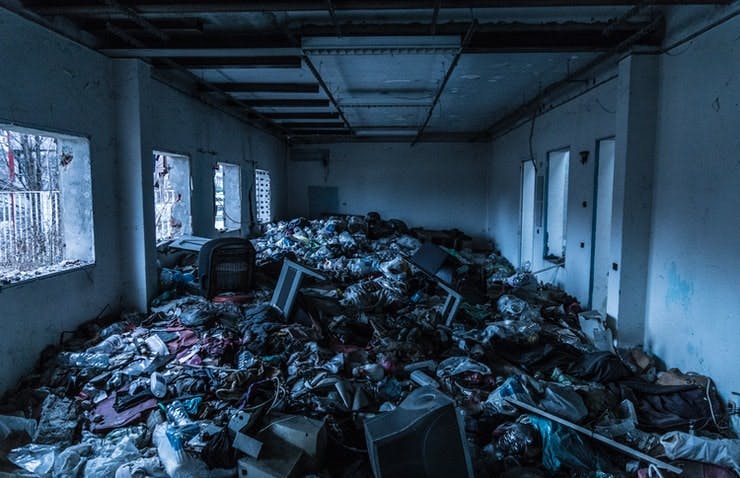10 Hazmat Training Courses
We’ve compiled a list of the most recommended hazmat training courses that will equip your workforces with the skills and knowledge they need to safely and responsibly perform their hazmat job. Among the topics covered here include safe handling of hazardous materials, hazard communication, Globally Harmonized System standards, and incident reporting. Keep scrolling to learn more.
Last published: 6th May 2024

1. Hazardous Materials (Silica, Polymerics and Waste)
If your workforces deal with a variety of hazardous materials but aren't knowledgeable enough about these products or the dangers that come with them, then your business will be in serious trouble. Sooner if not later, you will eventually face a series of mishaps due to product damage or poor handling, which could result in penalties ranging from tens of thousands of dollars worth of fines to imprisonment. Save your business from all these hassles by rolling out this free SC Training (formerly EdApp) course to your team, which has virtually everything you need to know about hazmat. They will gain more familiarity with the different types of hazardous materials, especially those containing polymeric and crystalline silica, as well as learn responsible handling and managing of these materials and safety precautions to stay safe at all times. It will also guide them to the safe and proper polishing and cleaning of chemicals and storing and comply with proper disposal of hazardous waste.
This hazmat training course only consists of four micro elearning lessons that your team can complete in just minutes, not hours or days.
Cost: Free
Scope: Types of hazardous materials, polymeric and crystalline silica exposure, safe handling and managing of hazmat, polishing and cleaning of chemicals, responsible hazmat waste disposal
Created By SC Training (formerly EdApp)
Explore this free course
2. Globally Harmonized System (GHS)
GHS (Globally Harmonized System) is a worldwide safety program developed to create a harmonized and standardized system of classifying and labeling hazardous chemicals and hazardous substances. In this SC Training (formerly EdApp) course, your hazmat team will learn about this systematized classification system, from its history and background to application and implementation, as well as how hazard classification and communication works. It also explores the different hazard classes under the GHS standards, alongside a step-by-step process of identifying and classifying them. The primary objective of this course is to patch up the confusing aspects of the classification and labeling of chemicals, ensuring consistent and simplified communication between involved workers, contractors, and manufacturers.
To engage learners, SC Training (formerly EdApp) added gamified quizzes into this course, like Strike-out, Image/Word Match, True or False, and more. If you want to further motivate them into completing their lessons, feel free to combine them with some exciting prizes and rewards, like vouchers or discount coupons.
Cost: Free
Scope: Introduction to GHS, application and implementation, hazard classification, hazard communication
Created by SC Training (formerly EdApp)
Explore the course
3. Hazard Communication
SC Training (formerly EdApp)’s Hazard Communication course focuses on educating hazmat workers about occupational safety, hazard communication standard, and the different hazards surrounding a chemical. Here, they will learn more about the physical, health, and environmental risks associated with these harmful substances, when and how they occur, and the steps they can take to ensure optimal safety at all times. As they progress through these lessons, they will also gain a thorough understanding of the components of GHS-compliant chemical labels and material safety data sheets (MSDS). This way, they can easily identify the hazards and toxicity of the chemical products they will be working with as well as the best practices to avoid accidental exposure or any related incidents.
This microlearning lesson only contains 11 short but highly concentrated slides that your team can complete in just 5-10 minutes. If you have remote employees all over the world, you can also use SC Training (formerly EdApp)'s AI translation tool to translate it into different languages, like Spanish, Japanese, or Arabic.
Cost: Free
Scope: Different types of chemical hazards, how and when they occur, steps to eliminate or reduce them, elements of GHS-compliant chemical labels and safety data sheets
Created by SC Training (formerly EdApp)
Explore the course
4. Hazmat: Reporting An Incident
Prompt incident reporting gives management a chance to identify premature problems and address them immediately before they lead to something catastrophic. In this J. J. Keller and Associates training course, your workers will learn all about the hazard communication standard, such as when and how to raise a hazmat incident via phone or submit a written report to Pipeline and Hazardous Materials Safety Administration (PHMSA). It has also included some tips on how to present hazmat incidents and issues as clearly as possible, like who to call and what they should include in their incident report.
Just one thing to bear in mind — this workplace safety training only targets workers with enough knowledge about hazmat as it will only tap on the essential elements of hazmat reporting.
Cost: $25 USD
Scope: Intro to incident reporting, when and how to submit telephone and written incident reports
Created by J. J. Keller and Associates
Explore the course
5. Controlling Hazardous Energy: Lockout/Tagout
Before servicing or repairing any machines, it is extremely vital to ensure that their power sources are completely disconnected and properly locked out/ tagged out. This safety precaution will help prevent hazardous energy from being released, and at the same time protect everyone from potential health problems due to accidental contact or exposure. Perhaps you have employees who are regularly servicing or repairing machines or any other workplace equipment? Providing them with this Lockout/Tagout training course from SC Training (formerly EdApp) will give you peace of mind knowing that they understand the different types of hazardous energy and their impact on their safety, and most importantly, they recognize how to carry out lock-out and tag-out procedures. Upon course completion, they will also gain a better understanding of different labeling systems and warning signs. This skill will be of great use when determining whether or not a machine is safe for operation.
This course is free and ready for deployment, although it can also be edited and rebranded whenever needed. Through SC Training (formerly EdApp)’s free authoring tool, you can tweak and edit its content, or even add your company’s policies, procedures, and updates, all up to you.
Cost: Free
Scope: Lockout/tagout overview, different types of energy hazards and their impact on safety, lockout/tagout procedures
Created by SC Training (formerly EdApp)
Explore the courseExplore our library including hazmat training courses

6. Hazardous Waste Generator Training
Industries like chemical manufacturing, metal fabrication, mining, and petroleum processing regularly produce hazardous wastes that are potentially harmful to the environment or human health. If your business falls under any of these industries, then this course is for you. Hazardous Waste Generator Training from Hazmat School covers all of the OSHA requirements that waste generators must adhere to to avoid penalties and maintain the safety of their employees, the environment, and the general public. At the end of this course, your workers will be able to define the types and generation of hazardous wastes, understand how waste accumulation works, and identify safety considerations when collecting, storing, and disposing of hazardous waste. This course will also guide them on how to recognize and fill out a Uniform Hazardous Waste Manifest.
Workers will only need at least 4 hours to complete this training program. A certificate will also be delivered immediately upon course completion.
Cost: $125.00 USD
Scope: Different hazardous waste and regulations, different classes of generators, safety considerations for the accumulation of hazardous waste, how to recognize and fill out a Uniform Hazardous Waste Manifest
Created by Hazmat School
Explore the course
7. Multimodal Air & Ground Online Hazmat Training
This multimodal training course by Hazmat University provides the required initial or recurrent training guide for employees involved in the shipping and/ or transport of hazardous materials, whether through air, ground, or vessel. It delves into different types and classes of hazard materials, correct methods for identifying, labeling, and marking substances, and steps for checking correct packaging to ensure that no hazmat will be exposed or released into the air. It will also teach your employees how to accurately verify the shipper's declaration document for dangerous goods as required by national and/or international authorities.
Cost: $555 USD
Scope: Classification of hazmat, appropriate identification process of substances, verifying correct packaging, application of correct marks and labels, verifying shipper's declaration paper
Created by Hazmat University
Explore the course
8. Shipping Fully Regulated and Excepted Lithium Batteries and Cells
Lithium batteries present a range of potential hazards due to their toxic and flammable components. So if your business involves the shipping and transport of these dangerous products, your workers must be trained adequately on its safe and proper handling, packaging, and storing to avoid potential accidents. This CHEMTREC course will give your workers a general overview of chemical safety for lithium batteries and the hazards they pose during shipping. It will also guide them on the UN and non-UN packaging requirements, as well as proper marking and labeling procedures for hazard classification. As they progress through the course, they will also learn more about the shipper’s responsibilities in the transportation of lithium-ion or lithium metal batteries, and how they should respond in case of emergency.
Cost: Available upon request
Scope: Overview of lithium batteries and why they are considered hazardous during shipping, UN and non-UN packaging requirements, marking and labeling procedures, shipper’s responsibilities, emergency response
Created by CHEMTREC
Explore the course
9. Toxic Chemical
Toxic chemicals pose a range of health and environmental risks, so hazmat companies must ensure that their workers know the severity of risks associated with each chemical product they will most likely handle, especially before they start to work. In this course by SC Training (formerly EdApp), your team members will learn more about toxins and basic toxicology terminologies, various types of toxins, and how they differ from each other. This knowledge will come in handy when identifying the hazard classes and categories of chemical products and classifying or labeling them under the GHS standards. Later as they progress through the course, they will also learn how the trace of toxic chemicals can enter their body alongside some tips on how they can prevent them.
The hazmat lessons here are delivered into bite-sized segments to ensure an engaging and informative learning experience for your employees.
Cost: Free
Scope: Types of toxins, toxicology terminologies, routes of exposure, workplace exposure standards
Created by SC Training (formerly EdApp)
Explore the course
10. Chemical Storage and Handling
It goes without saying that one of the best ways to avoid chemical-related injuries and illnesses is by providing your workforces with the right training course, one that will teach them how to safely deal with different types of chemical materials. SC Training (formerly EdApp)’s Chemical Storage and Handling course will walk your team through the step-by-step process of properly storing and handling chemicals and addressing any emergency contact and exposure. It will also discuss in detail the pivotal sections of the Safety Data Sheet (SDS) and teach them how to read and understand them. This way, they will be able to determine the right precautionary measures they need to apply to reduce risks of chemical accidents and exposures.
This course is self-paced and can be accessed through mobile devices. Meaning, your hazmat employees are free to take and complete their learning requirements anytime and anywhere to their best convenience.
Cost: Free
Scope: Properly storing and handling chemicals, addressing any emergency contact and exposure, Safety Data Sheet (SDS)
Created by SC Training (formerly EdApp)
Explore the courseMitigate hazmat risks and incidents with hazmat training
Hazmat training is a specialized program designed to educate and train workers who deal with hazmat or hazardous materials like chemicals, batteries, petrol and kerosene, and obsolete computer equipment among others. These materials, especially if irresponsibly handled or disposed of, may cause minor to major damage to workers’ health or even the environment. The key to preventing hazmat-related accidents is by training your hazmat workers not only once but at least once every three years, or whenever there’s a regulation change set by your health administration. After all, hazmat companies are not only legally required, but also morally obligated to provide and ensure a healthy and safe work environment for their employees.